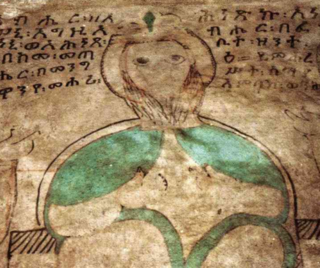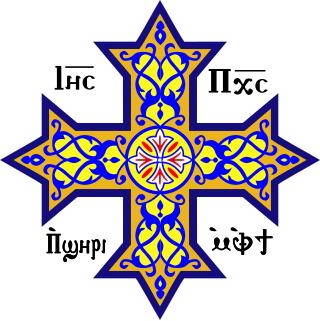Related Research Articles

Gudit is the Classical Ethiopic name for a personage also known as Yodit in Tigrinya, and Amharic, but also Isato in Amharic, and Ga'wa in Ţilţal. The personage behind these various alternative names is portrayed as a powerful female ruler, probably identical to Māsobā Wārq, the daughter of the last Aksumite king, Dil Na'ad, mentioned in an early Arabic source. She is said to have been responsible for laying waste the Kingdom of Aksum and its countryside, and the destruction of its churches and monuments in the 10th century AD in revenge for the church having cut her breast off and selling her into slavery. If she is the same as the Tirda' Gābāz in other Ethiopian sources, she is also said to have attempted to exterminate the members of the ruling dynasty. The deeds attributed to her are recorded in oral tradition and in a variety of historical narratives.

The Ethiopian Orthodox Tewahedo Church is the largest of the Oriental Orthodox Churches. One of the few Christian churches in sub-Saharan Africa originating before European colonization of the continent, the Ethiopian Orthodox Tewahedo Church dates back to the acceptance of Christianity by the Kingdom of Aksum in 330, and has between 36 million and 51 million adherents in Ethiopia. It is a founding member of the World Council of Churches. The Ethiopian Orthodox Tewahedo Church is in communion with the other Oriental Orthodox churches.

The Zagwe dynasty was a medieval Agaw Orthodox Christian monarchy that ruled the northern parts of Ethiopia and Eritrea. The Agaw are a Cushitic ethnic group native to the northern highlands of Ethiopia and neighboring Eritrea. Centered at Roha, it ruled large parts of the territory from approximately 900 to 1270 CE, when the last Zagwe King Za-Ilmaknun was killed in battle by the forces of the Amhara King Yekuno Amlak. The Zagwe are most famous for their king Gebre Mesqel Lalibela, who is credited with having constructed the rock-hewn monolithic churches of Lalibela.
Pope Christodoulos of Alexandria was the 66th Pope of Alexandria and Patriarch of the See of St. Mark.
Pope Cosmas III of Alexandria was the Coptic Pope of Alexandria and Patriarch of the See of St. Mark.
Pope John V of Alexandria, 72nd Pope of Alexandria and Patriarch of the See of St. Mark. He was initially a monk in the Monastery of Saint John the Dwarf in Scetes. He was enthroned as a Pope of Alexandria on the second day of Pi Kogi Enavot, 863 A.M..

Yekuno Amlak ; throne name Tesfa Iyasus was Emperor of Ethiopia, from 1270 to 1285, and the founder of the Solomonic dynasty, which lasted until 1974. He was a ruler from Bete Amhara who became the Emperor of Ethiopia following the defeat of the last Zagwe king.

Abuna is the honorific title used for any bishop of the Ethiopian Orthodox Tewahedo Church as well as of the Eritrean Orthodox Tewahedo Church. It was historically used solely for the head of the Coptic Orthodox Church in Ethiopia during the more than 1000 years when the Coptic Patriarchate of Alexandria appointed only one bishop at a time to serve its Ethiopian flock. When referred to without a name following, it is Abun, and if a name follows, it becomes Abuna.
Kedus Harbe was King of Zagwe dynasty. According to Taddesse Tamrat, he was the son of Jan Seyum, the brother of Tatadim. Some authorities date his reign to the years 1079–1119. G.W.B. Huntingford does not include him in his list of kings of the Zagwe dynasty.

Abune Theophilos, also known as Abune Tewophilos, was the second Patriarch of the Ethiopian Orthodox Tewahedo Church. He officially succeeded Abuna Basilios in 1971 after he had assumed the role of acting patriarch upon Abuna Basilios's death in 1970.
Mara Takla Haymanot was King and the founder of the Zagwe dynasty. Some king lists give his name simply as "Mararah", and other King Lists as "Takla Haymanot".

Lalibela, regnal name Gebre Meskel, was a king of the Zagwe dynasty, reigning from 1181 to 1221. He was the son of Jan Seyum and the brother of Kedus Harbe. Perhaps the best-known Zagwe monarch, he is credited as the patron of the namesake monolithic rock-hewn churches of Lalibela. He is venerated as a saint by the Ethiopian Orthodox Tewahedo Church on 19 June.

Ethiopian ecclesiastical titles refers to the offices of the Ethiopian Orthodox Tewahedo Church, a hierarchical organization. Some of the more important offices are unique to it.

This article, dealing with the Coptic Orthodox Church in Africa, is about the Coptic Orthodox Church of Alexandria in African countries other than Egypt.

The Ethiopian Empire, also formerly known by the exonym Abyssinia, or simply known as Ethiopia was an empire that historically spanned the geographical area of present-day Ethiopia and Eritrea from the establishment of the Solomonic dynasty by Yekuno Amlak approximately in 1270 until the 1974 coup d'etat of Emperor Haile Selassie by the Derg. By 1896, the empire incorporated other regions such as Hararghe, Gurage and Wolayita, and saw its largest expansion with the federation of Eritrea in 1952. Throughout much of its existence, it was surrounded by hostile forces in the African Horn; however, it managed to develop and preserve a kingdom based on its ancient form of Christianity.

Abuna Basilios was an Ethiopian-born first Archbishop or Abuna, and later the first Patriarch, of the Ethiopian Orthodox Tewahedo Church.
Abuna Yohannes was an Abuna, or head of the Ethiopian Orthodox Church in the 14th century, during the reign of Emperor Amda Seyon. He was accused of simony by a group of Ethiopian clergy at the Royal Court.
Bartalomewos of Ethiopia was an Abuna, or head of the Ethiopian Orthodox Church from 1398/99 to sometime after 1434; he succeeded Abuna Salama II. His tenure was a period marked by a series of doctrinal disputes in the Church, and at one point Bartalomewos was accused of denying the threefold nature of the Holy Trinity. Emperor Yeshaq appointed a committee to investigate this serious charge, whose members included graduates of the school at Istifanos Monastery in Lake Hayq.
Abuna Sawiros (Severus) was an Abuna, or head of the Ethiopian Orthodox Church in the 11th century.
References
- 1 2 Marie-Laure Derat (2010), "The Zagwe dynasty (11-13th centuries) and King Yemrehanna Krestos", Annales d'Ethiopie, 25, p. 164
- ↑ Margery Perham, The Government of Ethiopia, second edition (London: Faber and Faber, 1969), p. 104
- ↑ Taddesse Tamrat, Church and State in Ethiopia (Oxford: Clarendon Press, 1972), p. 55.